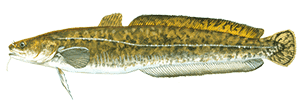Burbot

Species Details
Lota Lota
Lotidae
Gadiformes
Lake, River
2 - 25 lbs.
12" - 60"
Burbot (Lota lota) Fish Description
The Burbot appears to be the only cod-looking freshwater fish. Appearance-wise also, it looks like it’s a hybrid between an eel and a catfish. It has a short barbel under its chin. However, genetically, they say it’s more related to a cusk and a common ling.
Burbots have a serpentine body that’s mottled in black. The rest of its body is a bright yellow. It has a long, pale-blue dorsal fin split into two sections. The second section being the longer end that reaches all the way to the tailfin. The Burbot has a short, square-edged fin, and a golden anal fin that doesn’t have spots. Only the pectoral, dorsal, and tail fins appear to be covered in spots.
Burbot Diet and Size
Burbots in terms of diet aren’t too picky. They usually feed on smaller creatures such as zooplankton. When Burbots become older, they start eating greylings, lampreys, and young northern pikes. They are also known to eat young trouts and perches. Suckers and sticklebacks also become part of their diet after a while.
Burbots on average grow up to 16 inches. However, some people reported that Burbots can grow between 12 to 47 inches. They can also become quite heavy, weighing between 2.2 lbs to 26.5 kg.
Interesting Facts about the Burbot
- The Burbot earned its name from its barbel.
- Its name was derived from the French word, Barbot.
- Even its scientific name – Lota Lota – is derived from Lotte, the Old French word for Barbot.
- Burbots cannot stand strong currents.
- In the United Kingdom, some say that the Burbot may be extinct.
- However, in an article by the Guardian posted last March 2020, they are slowly being reintroduced.
- Some say however are still common in North America which is why some people are not entirely sure if the Burbot is extinct or not.
- Burbots can coexist with beavers.
- Beavers create dams that slow down the water current, making it easier for Burbots to thrive.
- Burbots are capable of living in freezing temperatures.
- Burbots live under frozen waters where they manage to lay their eggs.
Burbot – Fishing Techniques: How to Fish for a Burbot
According to some anglers, Burbots are not lure-shy. Most of all, they are not picky. Because their diet isn’t specific, people can utilize any kind of bait and they’re bound to close in. However, using cut bait from trouts, perches, Northern Pikes might help.
Once you have your bait, many say to weigh it down so it can sink down immediately. Usually, the best time to fish for them is when the water is frozen over. Unlike other fishes, Burbots are comfortable in cold temperatures. They are quite active so fishing in the wintertime or at least when the waters begin to freeze over might heighten your chances.
Some people use a flash lure which is a kind of lure that glows. Make sure you do charge your lure every 15-20 minutes as it sometimes dims out, making you lose out on your chance to snag a Burbot.
Burbot Habitat and Distribution
Burbots love cold waters. Freezing rivers, lakes, and reservoirs as long as it’s a freshwater body. Though, they do make exceptions for brackish water which is the time they usually spawn. They dig and hide into different kinds of substrates. They don’t appear to be picky about it however they usually are found rolling in mud, gravel, sand, silt, and boulders especially when they’re looking for food.







